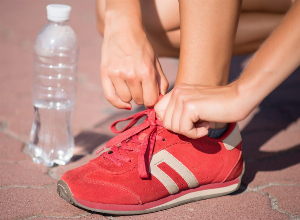The benefits of physical activity in the management of ankylosing spondylitis
Published 25 Aug 2023 • By Claudia Lima
Ankylosing spondylitis is a chronic inflammatory disease that mainly affects the spine and pelvis. It can cause stiffness, pain and reduced mobility.
In terms of management, a growing body of research suggests that well-adjusted physical activity can play an essential role in the management and treatment of AS.
What are the many benefits of exercise for AS patients? What are the best sports to practise?
Find all the answers in our article!

What is the treatment of ankylosing spondylitis?
Ankylosing spondylitis is a chronic inflammatory disease affecting the joints of the spine, hips or lower back. It essentially causes pain and fatigue, manifesting itself by periods of flare-ups, or attacks, alternating with periods of remission and a lull in symptoms.
To relieve the symptoms of pain associated with AS, symptomatic treatments are usually prescribed, such as non-steroidal anti-inflammatory drugs, analgesics and corticosteroids, but there are also disease-modifying treatments (immunosuppressants, biomedications), administered when the first option didn't work.
A number of non-medicinal measures can also be used in the treatment of ankylosing spondylitis, such as rehabilitation, surgery and non-conventional medicine.
In order to maintain or improve mobility and strength, and to prevent or reduce spinal deformity, daily stretching exercises are recommended, as well as the practice of non-traumatic sports.
What are the benefits of exercise in the treatment of ankylosing spondylitis?
Among the various therapeutic approaches for relieving the symptoms of ankylosing spondylitis, physical activity plays an essential role. However, it is necessary for each patient to be accompanied individually and advised by a specialist because the disease develops differently from one person to another and can affect different parts of the body. If, after physical exercise, the pain increases, it should be discontinued immediately and avoided in the future.
The prescription of individual exercise plan must be based on a thorough assessment of the person's mobility and the degree it has been affected by ankylosing spondylitis, according to several classification criteria:
- The form of ankylosing spondylitis: axial and/or peripheral,
- Duration of symptoms, age of patient,
- Types of spinal pain, arthritis, enthesitis, uveitis, dactylitis, psoriasis, Crohn's disease, etc.
Most types of exercise are safe for the majority of patients. However, any physical changes or new symptoms following a new attack should be taken into account.
Physical activity helps to:
Reduce pain
Physical activity releases endorphins, the happiness hormones that have a natural analgesic effect. Physical activity helps reduce the the fear of moving by making movement a pleasure. By mastering more movements, you feel less pain.
So regular exercise can help reduce the perception of pain and improve your mood. A recent study suggests that sporting activity increases the body's tolerance to pain.
Improve joint mobility
Patients with ankylosing spondylitis often have problems with joint mobility due to inflammation and stiffness of the joints. This is due to acute inflammation of the enthesis, the part of the bone where tendons, ligaments and capsules are inserted. When the inflammation subsides, it leaves a scar made up of fibrous tissue, which gradually ossifies. This can lead to ankylosis (reduced mobility, or absence of it, in a joint) in the back, cervical spine, ribcage, shoulders, hips, etc.
Regular range-of-motion exercises can help maintain and improve joint flexibility. Gentle stretching can help prevent joint fusion and maintain better mobility.
Strengthen the muscles
It is important to work on the strength of the muscles in the back, abdominal muscles and legs. Light weight training can help strengthen the muscles that support the joints affected by ankylosing spondylitis. In addition, posture is improved, which is important for preventing spinal deformity.
Stronger muscles make the body stronger, more mobile and more functional. It also limits injuries and prevents pain.
Improve general well-being
Managing a chronic illness such as ankylosing spondylitis can sometimes be difficult. Regular physical activity can play an important role in managing stress, anxiety and depression. Physical exercise releases neurotransmitters such as serotonin, which are linked to improved mood and mental health. Sport also improves sleep quality.
Increase lung capacity
As ankylosing spondylitis progresses, it is possible to observe a reduction in breathing capacity, which can seriously disrupt patients' daily lives and have cardiovascular consequences.
Breathing exercises can help preserve and improve lung capacity, as well as the mobility of the rib cage and ribs.
Avoid complications
Prolonged inactivity can lead to a loss of bone and muscle density, which can worsen the symptoms of ankylosing spondylitis. Regular physical activity helps prevent these complications.
What sports can you practice if you have ankylosing spondylitis?
The frequency, intensity, duration and the type of exercise should be adjusted to the goals and lifestyle of people affected by ankylosing spondylitis.
Here is a list of the most suitable physical activities for people with AS:
- Walking, hiking,
- Cycling,
- Cardio exercises in a gym,
- Swimming (especially on your back),
- Weight training,
- Dancing,
- Yoga, Tai-Chi, etc.
Certain sports should be avoided, such as combat sports (boxing, judo) and high-impact sports (rugby, running).
It should be noted that if a person with spondyloarthritis wishes to take up a sport that is not recommended for them, they can possibly still do so, depending on their health and physical form.
If you want to be regular in your physical activity and reap the maximum of benefits, you need to take the time to choose your favourite exercises carefully, and then stick to them, encouraging and motivating yourself and learning to self-manage.
According to various health authorities across Europe, physical activity is considered a non-medicinal approach to treating certain conditions, which plays an important part in preventing and improving the symptoms of many chronic diseases.
For this reason, regular physical activity should not be overlooked as a complementary treatment in the management of ankylosing spondylitis. However, patients should work closely with their healthcare professionals to design an exercise programme tailored to their needs and limitations. The aim is to strike a balance between adequate physical activity and the rest needed to avoid exacerbating symptoms.
By combining an appropriate medical approach with an active lifestyle, patients with ankylosing spondylitis can improve their mobility, reduce pain and increase their quality of life.
Take care!
Sources :
Spondylarthrites : symptômes, causes, traitement et prévention, vidal.fr
Spondylarthrite ankylosante, ameli.fr
Spondylarthrite ankylosante et sport : les activités à pratiquer, toutpourmasante.fr
Consultation et prescription médicale d’activité physique à des fins de santé chez l’adulte, has.fr
Recommandations spondylarthrites ankylosantes, vidal.fr
Exercise for ankylosing spondylitis: An evidence-based consensus statement, sciencedirect.com

 Facebook
Facebook Twitter
Twitter


